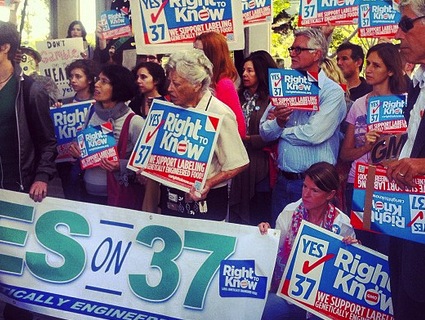
How much would it raise prices if manufacturers switched to non-GMO corn for corn flakes? Likely a fraction of a penny per serving. <p><a href="http://www.flickr.com/photos/15959219@N07/4568275404/in/photolist-7XFB83-6ERe5e-9zhNDK-dQkJwR-n1MgV-7xcKxA-9jzXnz-dQrhru-ap8z2r-a5UkAN-a5UtBG-a5UtHE-a5RCHz-a5RAjZ-a5UtxQ-a5RAiZ-a5UtFE-a5UtKw-a5Uram-a5Ure1-a5RCNR-bpmexF-cWmMnJ-a5RDpX-AC8vC-6FXyGd-cfigYd-e9ASMv-6Teo6r-a9Zi5c-7W9Bgz-882hrA-6zvefN-8rJotp-8rJob2-86iHJA-dQkLTx-8S1WYP-8S1WYR-8S1WYK-8S1WYD-8S1WYH-dQrm4h-dQkHqn-9MGdrm-4GnQrt-7B87ta-7B88zT-68yoga-aUjSWV-7bouFX" target="_blank">Islip Flyer</a>/Flickr</p>
The push to require labels for genetically modified food, which flared up in California before drowning under a flood of industry cash last year, is now underway in Washington state. Predictably, agrichemical and organic interests are pouring money into, respectively, defeating and supporting a ballot initiative called I-522, which would require foods containing GMO ingredients to bear labels. Just as predictably, the agribusiness interests are garnering much more money to kill the effort than their organic peers are in supporting it—outspending them $17.1 million to $4.6 million, the Spokane-Review reported.
Meanwhile, in a development that broke late Wednesday, the Washington state attorney general has filed a complaint alleging that the Grocery Manufacturers Association, a trade group that donated $2 million to the effort to defeat California’s labeling initiative, violated state campaign laws and “spent more than $7 million while shielding the identity of its contributors,” according to its press release.
As in California, the effect on food prices is emerging as a point of contention. Opponents of labeling, pointing to a 2012 study prepared during the California fight by Northbridge Environmental Management Consultants, say that the new rules would cost consumers $350 to $400 annually per household. The Northbridge paper, though, was funded by the industry-dominated campaign to stop Prop 37, as the California initiative was known. Campaign records show that Northridge received a total of $97,371 in five payments during 2012.
Supporters of the Washington initiative, in turn, point to a rival 2012 study, this one prepared by Joanna M. Shepherd of Emory University School of Law, which found that “food prices [are] likely to remain unchanged for consumers.” That study was commissioned by the Alliance for Natural Health, a group that advocates for “the right of natural-health practitioners to practice and the right of consumers to choose the healthcare options they prefer.”
So which is right? Over at Grist, Michael Lipsky, a distinguished senior fellow at the progressive think tank Demos, argues that labeling wouldn’t likely cost consumers much at all. The cost of changing labels would be trivial, he writes—food manufacturers “do it all the time.” Ever seen the words “new and improved” on some boxed delicacy?
The Northbridge study, he shows, is based on the assumption that, in order to avoid having to declare that their products contain GMOs, food manufactures will rapidly switch over to non-GMO ingredients, which would cost more to procure. That’s because upwards of 80 percent of US corn, soybeans, and sugar beets are genetically modified—and iterations of these three crops suffuse US processed foods, providing sweeteners (high-fructose corn syrup and beet sugar), fats (corn and soy oil), and a litany of ingredients like various thickeners. For food manufacturers to get non-GMO versions of these substances, they’d have to pay a premium in the marketplace—hence higher ingredient costs that they’d want to pass on to consumers.
But that effect wouldn’t last long, Lipsky argues. “If labeling were required, particularly if (and when) the labeling requirement is adopted by other states, demand for non-GMO versions of corn, soybeans, and sugar beets—the basic GMO crops—would increase, production would expand, and prices for non-GMO ingredients would decline,” he writes. That makes good sense: basic supply and demand.
And here’s something Lipsky didn’t get to: Even in the short term, the effect on retail prices would likely be small. That’s because ingredients make up a tiny portion of the expenses incurred by manufactures to process food and move it to grocery store shelves. Transportation, marketing, processing—all of these things cost more than the actual food in the box of cereal or frozen dinner at Walmart.
How tiny are the costs of ingredients? Consider a box of corn flakes—which are presumably made largely of GMO corn (it’s impossible to know for sure, because no US state requires labeling). In this 2008 report (currently available online because it has been republished on a non-government server) on the effect of ethanol on food prices, a US Department of Agriculture researcher crunched the numbers (pun fully intended) on the how much money companies spend on corn to make your cereal:
[A]n 18-ounce box of corn flakes contains about 12.9 ounces of milled field corn. When field corn is priced at $2.28 per bushel (the 20-year average), the actual value of corn represented in the box of corn flakes is about 3.3 cents.
And what happened after the corn ethanol program pushed corn prices up to $3.49 per bushel—a 49 percent jump? The total cost of corn in the cereal box rose to 4.9 cents. In other words, paying a 49 percent premium pushed up the corn cost in a box of corn flakes a grand total of 1.6 cents. An 18-ounce box of corn flakes contains 18 servings—meaning that much-pricier corn translated to an increase of less than 0.1 cents per bowl. For a family of four that consumes four bowls of flakes every day, that’s about $1.46 extra for the year.
So even if manufacturers had to pay a hefty premium for non-GMO corn, the retail price of food would barely budge. Whatever you think about GMO labeling, the concern that it would significantly jack up food prices is probably specious.
















